Hello again folks, welcome back and thanks as always for visiting the previous posts in this series about a trip round the North of England (and even a brief incursion into Scotland) and if you have not read it from the beginning you can do so here if you like. I realise that I start every post here with more or less the same thanks and it probably sounds like I am “gushing” but, believe me, I genuinely do appreciate it and wish to show that appreciation.
If you read the previous entry you will know that it was not so much a travelogue but rather a fairly amateur essay about the history of Carlisle which is where I had landed the day before and a discourse on the history of hostelling over the last half century. I promise I shall rectify that situation in this post and there is certainly a lot to see so please read on.
I began my day by standing on the step of the hostel and lighting my early morning cigarette which I fully appreciate is idiotic as it is a habit which has contributed greatly to my current medical woes. Don’t have a go at me, I know how stupid it is but having smoked for over 50 years I can only conclude that I am addicted and just do not have the willpower to stop.
After my first illness I was doing quite well and had taken to vaping and smoking, which I know is not ideal but better than where I was and at one point was down to three “proper” cigarettes a day which was not ideal for me but I was holding it together pretty well and it was certainly a lot healthier (a relative term obviously) than what I had done before. Then the Chinese let loose their evil virus on the world, we were all placed under effective house arrest and I just stopped caring, I stopped caring about just about anything to be honest.
Enough of all this and back to my doorstep where a quick look round showed me what a fantastically historic and interesting place Carlisle is although I think it suffers somewhat from being so close to the Lakes with the magnificent scenery, walking etc. This is entirely understandable as it is one of the most beautiful areas of the country but I think Carlisle probably deserves more tourist traffic as I hope to prove.


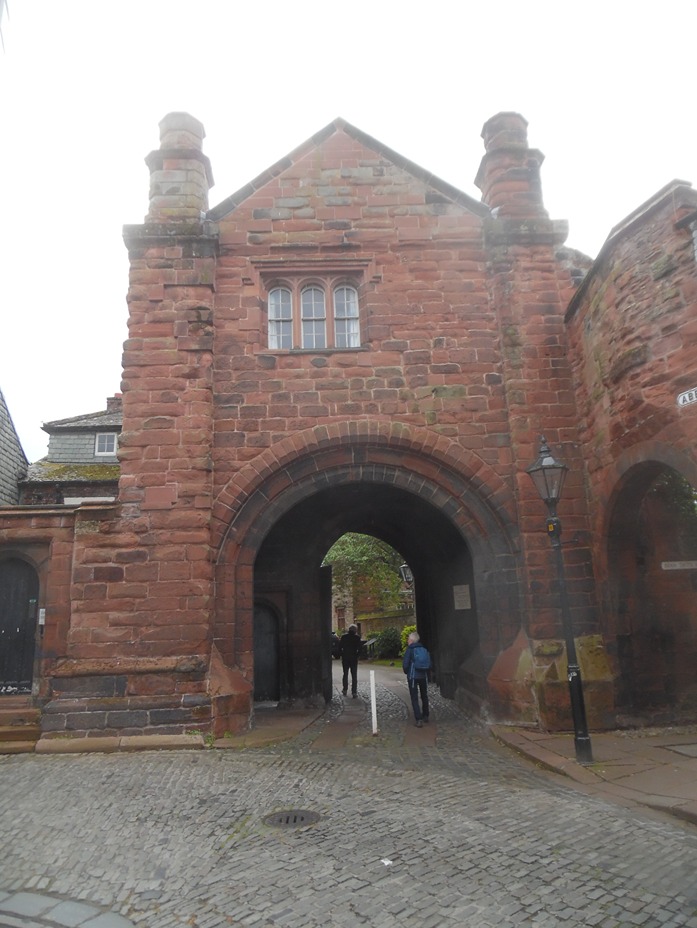
If I looked to my left I could see the walls of Carlisle Castle, directly in front of me were the beautifully manicured gardens leading to the Tullie House Museum and Art Gallery which was originally housed in a Grade I listed Jacobean House (and still is) and less than a hundred yards to my left was the wonderful gatehouse which is the entrance to the grounds of the cathedral which is where we are going right now. I had considered the other two options but chose the third as it was on my way back into town and I wanted a bit of a look about so shall we go for a walk (or hobble in my case)?
The gatehouse itself was constructed in 1528 during the reign of Henry VIII and only a few years before his dissolution of the monasteries (about 800 in all) with it’s pillaging of their vast wealth and wanton destruction of their buildings because this site housed not only the Cathedral but also a Priory. We are, however, getting way ahead of ourselves so let’s go back to the beginning and have a look at the history.
The Cathedral was originally begun in 1122 as a community of Canons Regular during the reign of King Henry I, possibly on the site of a previous church although this remains unproven. It is an indication of the fragmentary nature of the Judeo-Christian belief system that this Cathedral would be under the auspices of the Augustinian monastic order whilst there were Dominican and Franciscan monasteries very close by. This may be due to the fact that the Archbishop of Canterbury (head of the Church in England) was associated with that order although it is another oddity that only four Augustinian churches were raised to Cathedral status whilst most went to the Benedictine Order.
Honestly, the workings of the Church never fail to confuse me and the only thing I can say with any degree of certainty is that it was, as far as I can see then as now, concerned predominantly with power, wealth and the ability to control people.
In 1133 Athelwold, an Englishman rather than a Norman invader, became the first prior. The building was refurbished and enlarged in the 13th and 14th centuries and this process was inevitably assisted by the presence of King Edward I who was based there and held Court during his campaign of ruthlessly suppressing the Scots, an action which led to his long-standing nickname of “Hammer of the Scots”. In the 15th and early 16th century there was much refurbishment of the monastic buildings which could have been so much wasted money and energy when King Henry VIII began his Dissolution of the Monasteries in 1536 following his schism with the Church of Rome and the foundation of his own Church of England. Actually, the Cathedral got away relatively lightly as the nearby Franciscan and Dominican priories were done away with but it survived unscathed, replaced by a secular chapter who presumably were seen as no particular threat to the new Church. This situation continues to this day.
Whilst the Cathedral escaped the ravages of the Dissolution, it was not so lucky during the English Civil War (1642 – 1651) when part of the nave was torn down by the Scottish Presbyterian Army, fighting on the Parliamentary side, to reinforce the nearby Castle defences.
Between 1853 and 1870 the main Cathedral was restored by a chap called Ewan Christian who, apart from this project is probably best remembered for designing the National Portrait Gallery in central London, a fine building I have visited many times. After this 19th century little of note happened which leaves us with the magnificent structure we have today which really is very well worth a visit but we are not quite there yet as there are some fantastic buildings to see in the grounds.

Immediately through the gatehouse on the left is the building you can see above which I believe is a chapter house for one of the secular orders who run the Cathedral. I thought it looked rather grand.

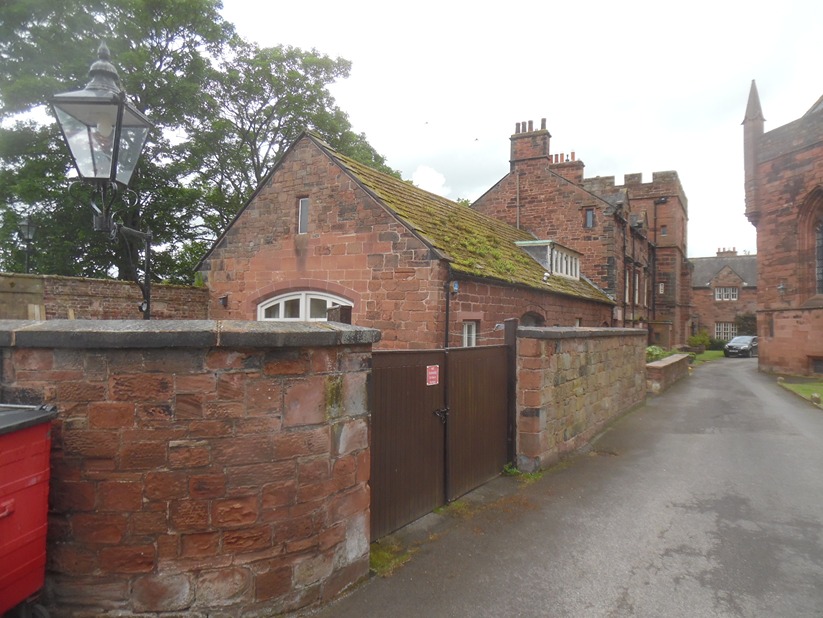
This even grander building is called the Deanery and the almost military looking pele tower in the middle is called the Prior’s Tower and indeed did have a quasi military function. An act of Parliament established the Towers, also known as peel towers, along the Scottish and Welsh borders which were large enough to shelter all the inhabitants of the immediate area in the all too regular case of raids by Scottish or Welsh raiders. Perhaps more importantly, they were to have a basket on the roof where a warning beacon could be lit to alert inhabitants to the danger.
I would have liked to visit as I have subsequently read that the interior is finely decorated but unfortunately it is not generally open to the public but is used as an educational facility. It sounds like a wonderful place to have a school class.


Again, I have no idea what the building shown above is but I did think it worthy of an image as was the wonderful old arch standing in splendid isolation near it although what it was originally part of I have no idea. I suspect it was purely decorative as there is surely no other need for an arch this close to the ground. The first image also inadvertently includes one of the several gardeners hard at work and their efforts really do pay off as the grounds are immaculate.
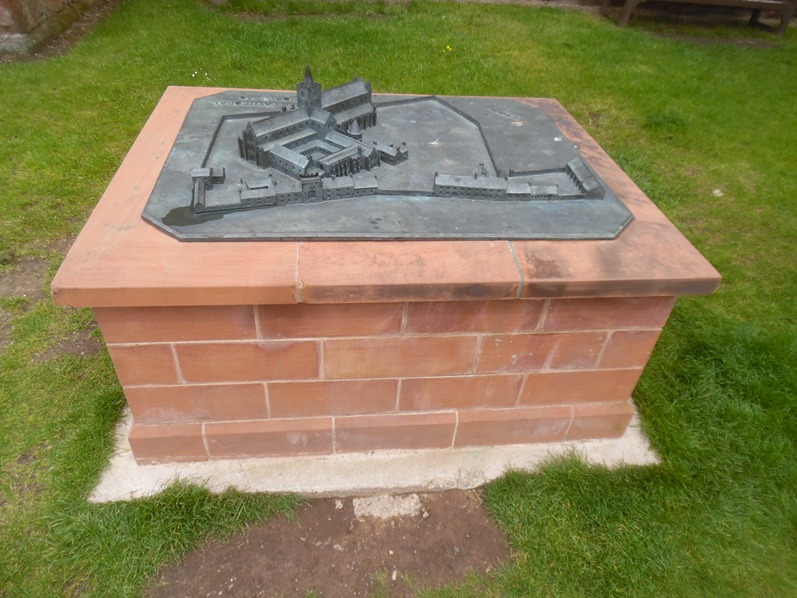
I also found this rather splendid 3D model of the Cathedral which I did rather like. Because of all the ancillary buildings it is quite difficult to get a good look at the Cathedral proper although my first sight did not disappoint and in I went. It is certainly not the largest Cathedral I have been in but I rather liked it and you can see a couple of images of the exterior below.


When I visit any place of interest I have almost an obsession with not missing anything and, although never diagnosed, I’ll swear I am borderline OCD in that respect and so I always work in a fairly methodical fashion. What you see here therefore are things more or less in the order I saw them rather than any order of importance although they are all of importance in their own way.

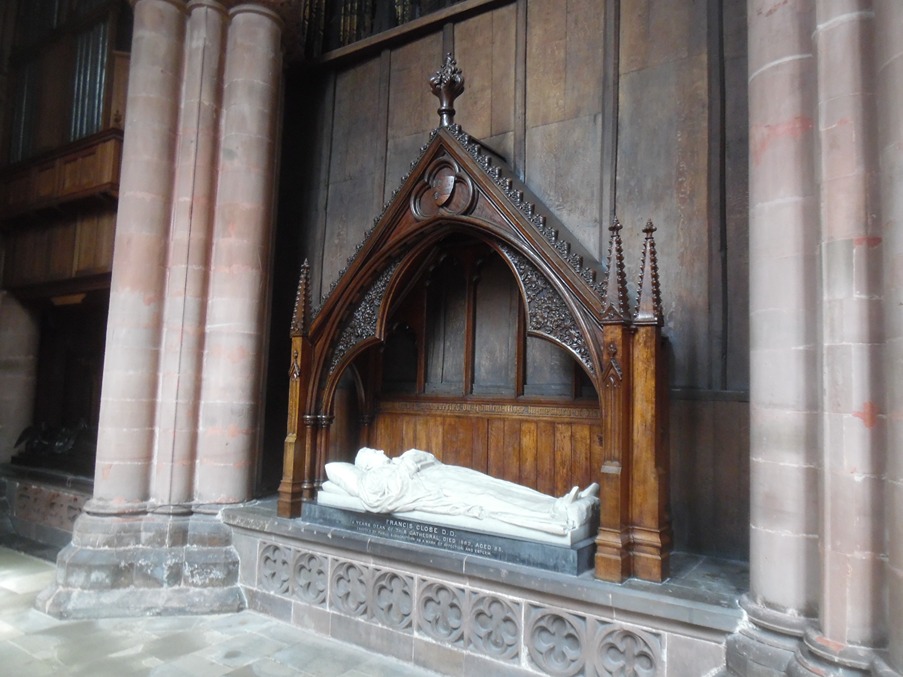
There are also various interments in the Cathedral, mostly under rather splendid monuments like the two shown above but they are almost exclusively those of former Bishops. I rather stupidly took no notes of who lies under the white effigy but I can tell you that the black effigy commemorates Harvey Goodwin, Bishop here from 1869 until his death in 1891.
After being born into an affluent family, he had an excellent education, notably at Cambridge University where he won several prestigious prizes. Combining a noted academic career with becoming a cleric he was eventually offered a Bishopric in South Africa which he refused. Perhaps he didn’t like sailing or the heat or just did not want to be 登ut of sight, out of mind but he was eventually offered the Bishopric of Carlisle which he accepted. If you were to open this memorial you would find it empty as Goodwin is actually buried in Keswick but I thought the effigy particularly well-rendered and this is not surprising as it was done by Hamo Thornycroft who is probably best known for his famous statue of a mounted Oliver Cromwell which stands to this day outside the Houses of Parliament.
I learned precious little at school and the fault is entirely mine as it was a good school but one life lesson I learned and have retained for over 40 years was imparted to me by our wonderful Vice-Principal, Fred Jeffrey who sadly must be dead now or else he is the oldest man in the UK. He was giving us a presentation on architecture and his advice was to always look up which is an excellent tip.
If you walk along any High Street in Europe you will most likely see nothing but generic globalised neon signs, predominantly for fast-food outlets but look up and the chances are you will be treated to a feast of the original architecture. Nowhere is this more true than Oxford Street in London, one of the most famous shopping thoroughfares in the world where some of the architecture is excellent. Obviously the principle does not apply to the numerous cities that were flattened in the Second World War but it is a good rule of thumb.

Looking up outside is undoubtedly rewarding but it also reaps numerous benefits inside and Carlisle Cathedral is a prime example as the image above hopefully shows, it is quite magnificent and is presumably supposed to represent God’s infinite Heaven (as they believe) as I can find no other reason from my research.
Whilst the timbers upon which it is painted date to the 14th century, replaced following the devastating fire of 1292 the painting is much more recent and was painted to the design of Owen Jones in 1856 during the major refurbishment under the auspices of Ewan Christian.
Another of the many notable features of the Cathedral is the impressive organ although again it is nowhere near as old as you might think. The earliest mention of an organ here is an inventory of 1571 although there have been several replacements since then. The magnificent instrument you see here is called the Willis organ after the man who designed and built it, Henry Willis. He is credited with completely changing the way organs were designed and built and he was so respected amongst his peers that he earned the nickname Father Willis. He was as prolific as he was talented and is credited with approximately 1,000 instruments during his career. When you consider how long it takes to design, build and install a church organ this really is a prodigious output.

The lectern is also notable, a fine brass of an eagle in flight although I can find no information as to who was responsible for it. For some reason it rather reminded me of the emblem of the Roman Army who had such a presence in this area and wonder if it was some form of “cultural memory” whether conscious or otherwise, that inspired the creator.
I have mentioned before that stained glass is one of my favourite artistic media, I find it is often so intricate and the level of skill required to paint some of the images I have seen is amazing.

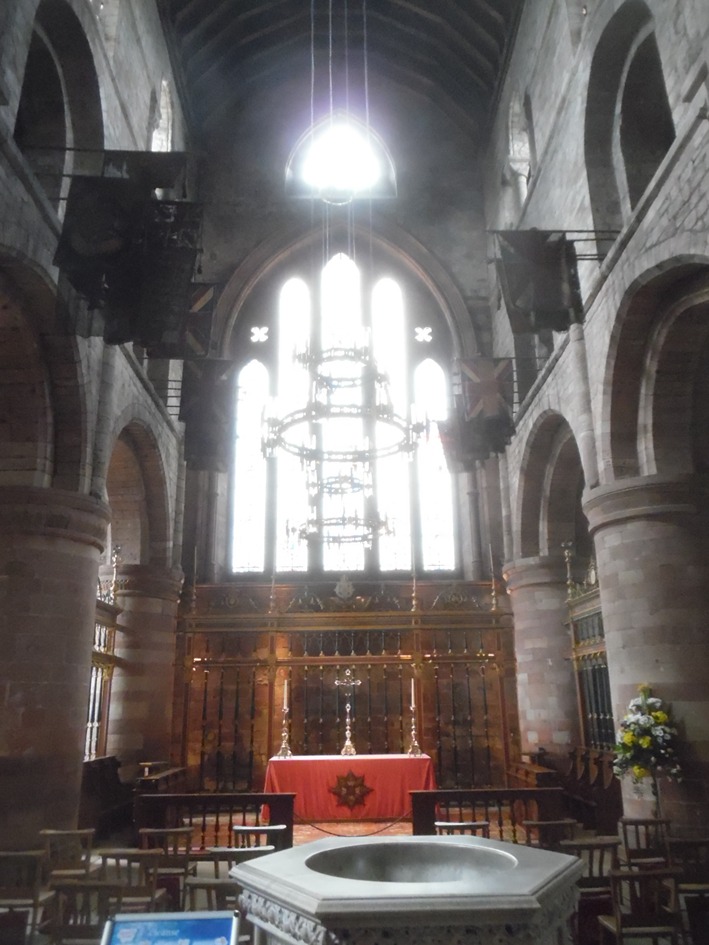
By one of the strange coincidences that seem to follow me around, the guy who I am staying with now used to own one of the larger glazing firms in Kent which specialised in stained glass. We had a great conversation the other day in the pub and he was giving me chapter and verse on the whole process from designing right through to installation and it was absolutely fascinating. I should explain that John and I have been mates for perhaps 25 years and our relationship is much more based on that rather than the fact I am effectively his lodger. I have included a couple of images here to give you a flavour of what to expect although one of them are not exactly great due to incoming light and a very basic pocket camera.


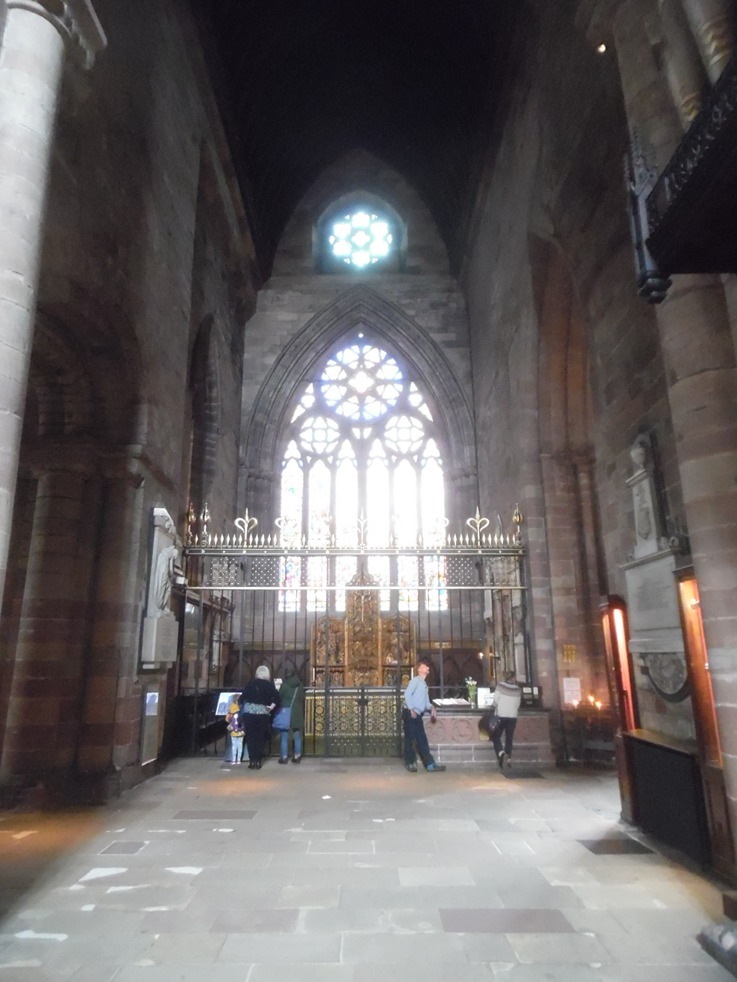
With my great interest in military history I was intrigued to see the Regimental Chapel of the Border Regiment although this plaque is now out of date and the place should properly be called the the Chapel of the Duke of Lancaster’s Regiment as constant Government cut have led to amalgamation of so many old, proud Regiments which annoys me greatly. I am not going to delve too far into the history of the Regiment as we shall visit their Regimental Museum in a future post so I shall save it until then. I could see plenty of laid up colours but regrettably the chapel was no open so I had to content myself with an image from outside whilst holding the camera through the bars of the iron gates. Perhaps another time.

Just adjacent to the erroneous sign was another plaque commemorating a very brave man in the First World War who never even carried a gun and was never even attached to any of the local Regiments. Allow me to explain.
Hardy was born into a relatively affluent family in Exeter, Devon in 1863 and received a good education culminating in his graduation from the University of London. After this he entered a career in teaching becoming an assistant Master at Nottingham Grammar School between 1891 and 1907 where he taught, amongst many others, the famous if controversial writer DH Lawrence. It was during this period, in 1898, that his religious inclination prompted him to be ordained as a Minister in the Anglican Church.
From Nottingham he moved to Bentham in West Yorkshire to be Headmaster there and remained until 1913 when he accepted a post as vicar of Hutton Hole, a small village in what was then Westmoreland.
I am guessing here but the reason he resigned from teaching, apart from his new Parish, was that he may well have so to better care for his wife Florence Elizabeth who was battling illness, a battle she finally lost in 1914. This was the year the Great War broke out and it was during this conflict that he was to distinguish himself greatly. Having researched the man I have wondered if his at times almost reckless bravery may have been somehow linked to his recent tragic loss.
Deemed to be too old for active service he was eventually appointed CF (Chaplain to the Forces) in August 1916 with the honorary rank of Captain. This was only after persistent badgering of the authorities who thought there were much younger men available. He was posted to the Western Front where he was given pastoral responsibility for the 8th Battalion the Lincolnshire shire Regiment and 8th Battalion Somerset Light Infantry. Whilst this makes no geographic sense in terms of raising areas I can only surmise the Lincolnshire lads and the West Country boys must have been posted near to each other in the Hell of the trenches.
You might have thought that Chaplains would sit well to the rear of the fighting conducting services, comforting the wounded and handing out cups of tea but this is far from the case. I remember some years ago visiting the excellent Dover Castle (highly recommended), specifically the delightful St. Mary in Castro Church which is still the Garrison place of worship.
They had an excellent exhibition about the Chaplain’s Department and I was amazed that the they had amassed five VC’s (Victoria Crosses). This is the highest order of gallantry available to military personnel and is a hugely respected decoration. For non combatants who are not armed and from such a numerically small unit it was mightily impressive.
I was reading the Chaplains website whilst researching this piece (yes, I do go into that much detail which is probably why each post takes me so long) and discovered that “padres”, as they are known in military circles, now have teams of armed minders when they are in combat zones, which I think is very sensible. Imagine some of the recent conflicts we have been involved in and the concept of a kuffar (a jihadist term for non-Muslims) religious leader being taken alive by an Islamic terrorist group. It just does not bear thinking about.
In addition to the VC,s there were numerous MC’s (Military Cross), DSO’s (Distinguished Service Orders) and various other high ranking gallantry awards made to members of the Department, many posthumously. It appears that a man does not necessarily have to carry a gun to be useful in a war-zone, but back now to the Cathedral, the possibilities of which I had just about exhausted so I wandered back outside to consider my options.
This leaves leaves me on the horns of a dilemma which I suppose is infinitely preferable to being left on the horns of an enraged bull charging through the streets of Pamplona during the annual Running of the bulls which is an idiotic pursuit if you ask me. I suppose the one redeeming feature is that at least, unlike bullfighting, the animals at least have a sporting chance.
I do sometimes wonder how my disordered little brain operates flitting from a simple plaque in Carlisle Cathedral to an ancient and much loved Spanish festival in the space of a few short paragraphs, how does that work?
The dilemma is this. On one hand I am making a conscious effort to cut down on the length of my posts, some of which seem to me to be as long as Gibbon’s Rise and Fall of the Roman Empire. On the other hand I do not like splitting one day of exploration into more than one post as I feel it can become a bit disjointed but in this case, after much deliberation, this is the option I have chosen.
I do hope you have enjoyed this first part of what happened on the last day of May 2022 and if you want to discover what else I discovered on that very interesting and productive day then you’ll have to stay tuned and spread the word.
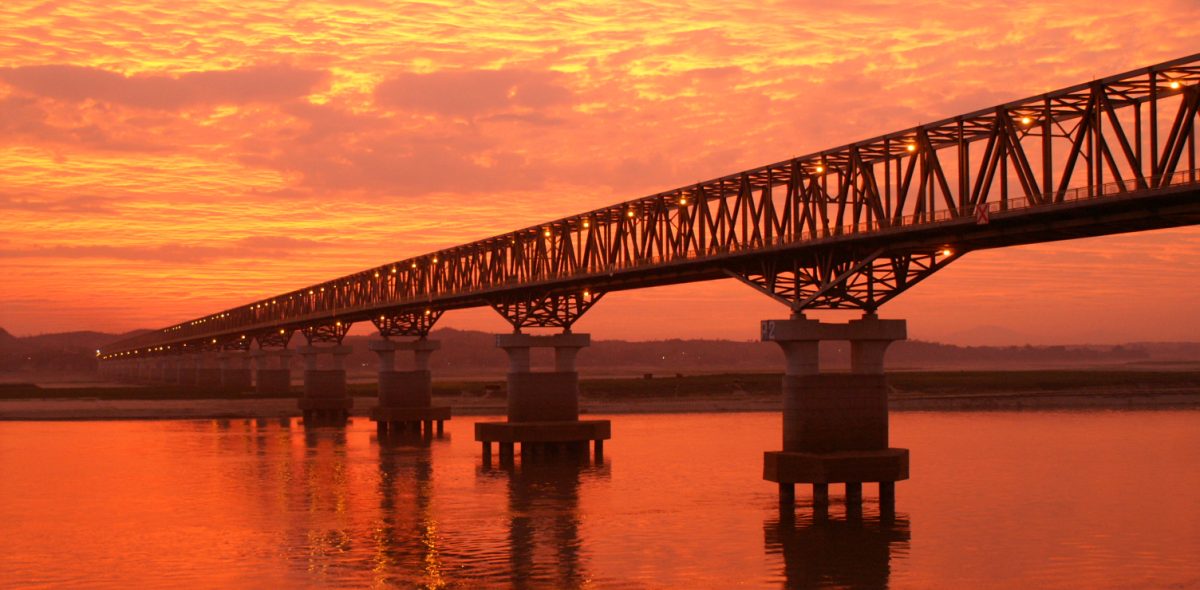
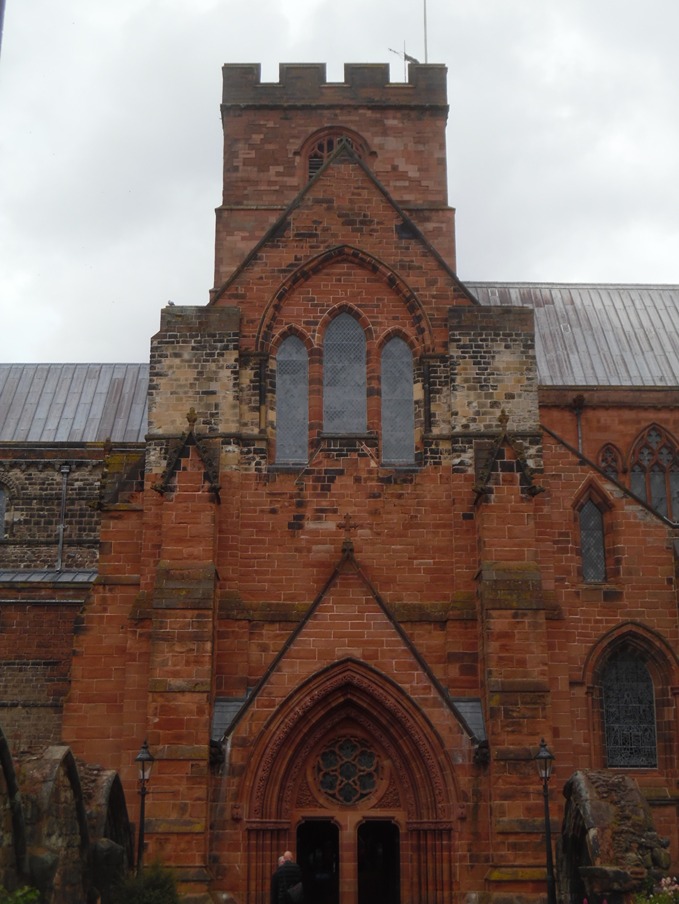
Uncle Ferg, we were back in the UK tracking you down last year and BigWig and me were very worried. Hopefully back for a visit soon. +27834093616.
LikeLike
Carlisle Cathedral and the surrounding grounds look so charming, even on a gloomy day. I’m such a fan of the stained glass windows too, which adds a pop of colour to the interior of the cathedral. Thanks for sharing.
LikeLiked by 1 person
My pleasure, it really is worth a visit if you are in the area.
LikeLiked by 1 person
Other than to change trains I’ve never been to Carlisle so this is all new to me, and very interesting too 🙂
LikeLiked by 1 person
You’re obviously quite taken with this cathedral, Fergy. I don’t know Carlisle too well as it happens. Anyway, we’re back in Kent now if there’s a chance to set up our proposed meet…so feel free to trawl through our posts from our tour of Mexico and Belize, it was an extremely interesting time for us. Look forward to the next Carlisle instalment.
LikeLiked by 2 people
Yes indeed, the cathedral is quite small and not really grandiose but, like most places, if you take the time to look round, you can find loads of interest.
I will indeed check the rest of your central Americas blog, I really enjoyed the first part and a prospective meet sounds good although my mobility is really bad at present but we’ll see how it goes.
LikeLiked by 2 people
Sorry to hear you’re struggling with mobility again. Let us know when you feel able to get out and about a bit again. Hopefully Phil and Michaela will still be in the country 😆 PS I’m away late October to mid November.
LikeLiked by 1 person
Not so sure about out and about as I am back in hospital and they do not seem to have a clue what’s wrong! Hey ho.
LikeLike
Oh dear, sorry to hear that. Do keep me posted please.
LikeLiked by 1 person
Hi mate,,
sure I’ll keep you posted as soon as the Docs afford mw the same ciurtesy. I have been here a week and STILL have more tests scheduled. They appear not to have a clue what is wrong.
LikeLike
Beautiful pictures of churches and so much information, interesting read as always – Thush
LikeLiked by 1 person
Thank you so much Thush, I am so glad you are enjoying this series. It is pretty time-consuming but hopefully it is worth the effort to get it right.
LikeLike
I love the interior of the cathedral! The red brick buildings are beautiful too. So much history!!!
LikeLiked by 1 person
It is nothing like the biggest nor grandest Cathedral I have ever been in but it certainly had plenty of interest. I must have spent two hours in there and it was fascinating.
LikeLiked by 1 person
Interesting day so far 🙂 I like the look of those red-brick-buildings!
LikeLiked by 1 person
They are very attractive, aren’t they. I know very little about architecture but I do like looking at it.
LikeLike